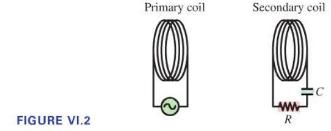What are the rms and peak currents for a (60 mathrm{~W}) bulb? (The rms voltage is the
Question:
What are the rms and peak currents for a \(60 \mathrm{~W}\) bulb? (The rms voltage is the usual \(120 \mathrm{~V}\).)
A. \(0.71 \mathrm{~A}, 0.71 \mathrm{~A}\)
B. \(0.71 \mathrm{~A}, 0.50 \mathrm{~A}\)
C. \(0.50 \mathrm{~A}, 0.71 \mathrm{~A}\)
D. \(0.50 \mathrm{~A}, 0.50 \mathrm{~A}\)
Researchers are working on ways to circumvent the need for a direct electrical connection for power, and they are experiencing some success. Recently, investigators were able to use current flowing through a primary coil to power a \(60 \mathrm{~W}\) lightbulb connected to a secondary coil \(2.0 \mathrm{~m}\) away, with approximately \(15 \%\) efficiency. The coils were large and the efficiency low, but it's a start.
The wireless power transfer system is outlined in Figure VI.2. An AC supply generates a current through the primary coil, creating a varying magnetic field. This field induces a current in the secondary coil, which is connected to a resistance (the lightbulb) and a capacitor that sets the resonance frequency of the secondary circuit to match the frequency of the primary circuit.
Step by Step Answer:

College Physics A Strategic Approach
ISBN: 9780321907240
3rd Edition
Authors: Randall D. Knight, Brian Jones, Stuart Field





